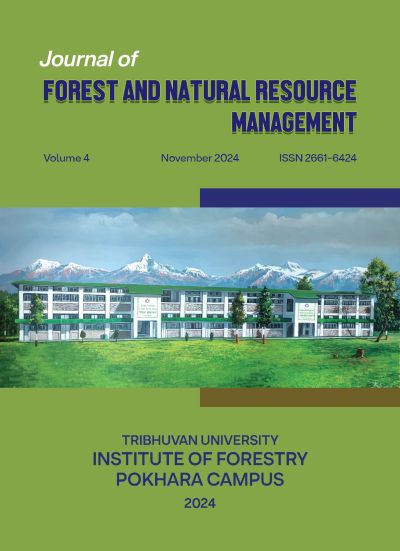Silvicultural Systems and Their Practices in Terai Forests of Nepal: A Review
DOI:
https://doi.org/10.3126/jfnrm.v4i1.74227Keywords:
Community forests, forest management, Nepal, rotation, silvicultural systemAbstract
It is more than eight decades that Nepalese foresters initiated appropriate silvicultural systems to obtain goods and services from forest, in perpetuity. Several forest management plans were prepared in the past. Unfortunately, these forest management plans were not implemented until 2012 AD. Government of Nepal had introduced a silviculture-based forest management procedure, known as Scientific Forest Management (SciFM) in 2014. One of the objectives of this procedure was to provide management guidelines for Community Forests (CFs) and government managed forests. It has been more than a decade that SciFM was implemented in Terai forests (CF and government managed forests) but how far the procedure supported in achieving its goal is not well documented. This paper examined the forest management system that was implemented in Terai districts of Nepal, irrespective of its management regime. For the study, field visits were carried out in five Terai districts (Morang, Kapilvastu, Dang, Kailali and Kanchanpur) during March and October 2021 to examine the procedure followed in managing the forests and observe the outcomes aimed by the procedure. Both published and unpublished literature on silviculture, silvicultural systems, and forest management, especially devoted to Nepalese context were reviewed. Operational Forest Management Plans (OFMPs) developed by government entities and Community Forests User Groups implemented “irregular shelter-wood system” of forest management in their respective forests, retaining some mother trees for shelter and obtaining quality seeds, based on 80 years of rotation period for Sal (Shorea robusta) although the basis of fixing the rotation is not very clear. The review indicates that, in most sites of Terai parts of Nepal, it may not be necessary to retain mother trees, for ensuring Sal regeneration. There is some possibility of estimating Sal rotation due to appearance of hollowness in the trees, which may help decide the harvestable age of Sal trees in future.
Downloads
Downloads
Published
How to Cite
Issue
Section
License
© Institute of Forestry, Pokhara Campus




